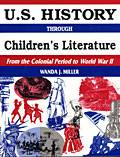This is a resource book for parents/teachers who want to use a real book approach for teaching U.S. history to students in grade 4 through 8. It is divided into nine topical areas: Native Americans, Exploration, American Revolution and the Constitution, Slavery and the Civil War, Pioneer Life and Westward Expansion, Immigration, Industrial Revolution, World War I, and World War II.
Each topical section features detailed studies for about six or seven books. The first study is supposed to be for an entire class, while the rest of the studies are supposed to be completed in small groups. Even so, the studies can easily be adapted with little effort for home school use with one or a few students.
Selected books are briefly summarized, approximate grade level is indicated, and biographical information on the author is given. Next, are activity suggestions that include map work, writing assignments, additional research, creation of posters, and role-playing. Discussion questions, which follow next, are easier or more difficult reflecting the suggested grade levels for each book. Last are a list of vocabulary words with definitions and the page number of the book where each word appears.
At the end of each unit, following these studies, is an annotated bibliography of books and other resources on plus an "End-of-Unit Celebration." The celebration involves foods representative of the topic (recipes included) and other activities and research projects. These tend to be more large group oriented than those following individual book studies. A final chapter includes a "Literature Response Guide" which seems too much concerned with feelings and personal reactions rather than historical fact. You can use it or not as you please.
The entire book is written for government schools, but it does present books that represent a variety of viewpoints. Consider this a supplement to enhance your U.S. history studies since it does not offer comprehensive coverage of even those topics under discussion. Choose whichever of the books to study that are appropriate and appealing; you need not go in order or complete all of them. I especially recommend this resource to parents who also have younger children with whom they can utilize the studies of some of the younger level books.
A second volume titled Teaching U.S. History through Children's Literature: Post World War II follows a similar format.









